A telling taste of Tibetan temples
Few of us actually delve into the world of Tibetan temples but Touch China does, for it brings with it a chance for you to get to know and understand more about Tibetan Buddhism and the ever-present Tibetan culture. Here Touch China pulls out the holiest, the precious and the downright riveting from an enthralling Buddhist world.
The Reverent:
Jokhang Temple
Wonder to Witness: The Jowo Rinpoche, a sacred image of the Buddha. It is the holiest object in Tibet.
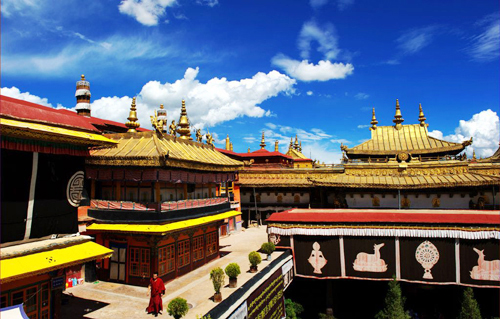
Jokhang Temple in Lhasa is the holiest site in Tibetan Buddhism, attracting crowds of prostrating Tibetan pilgrims and curious tourists every year. It hosts the annual Great Prayer Festival, as well as all ceremonies of initiation for the Dalai and Panchen Lamas.
Jokhang Temple was founded in 647 by King Songtsen Gampo, the first ruler of a unified Tibet, and his two of his wives who are credited with bringing Buddhism to Tibet. The temple was constructed to house a sacred image of the Buddha, the Jowo Rinpoche, which Queen Wengcheng brought with her from Tang Dynasty as a dowry. This statue is still enshrined within the temple and is the holiest object in Tibet.
Jokhang's interior is a dark and atmospheric labyrinth of chapels dedicated to various gods and bodhisattvas, illuminated by votive candles and thick with the smoke of incense. Although some of the temple has been rebuilt, original elements remain: the wooden beams and rafters have been shown by carbon dating to be original; the Newari door frames, columns and finials date from the 7th and 8th centuries.
The Prestigious:
Drepung Monastery
Wonder to Witness: The unfolding of the giant Buddha painting in the Shoton Festival.
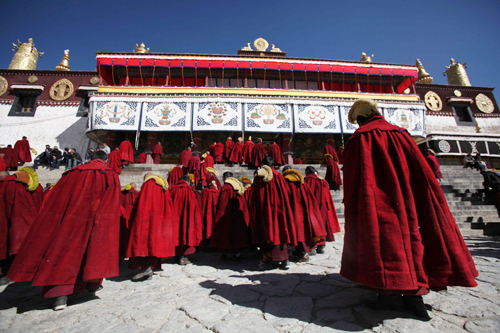
The Drepung Monastery is known as the most prestigious monastery of Gelugpa in Tibetan Buddhism. It is considered one of the 'Three Great Monasteries' and also the most important one. The other two are the Ganden Monastery and the Sera Monastery. Covering an area of 250,000 square meters, it housed as many as 10,000 monks in its heyday, and is the largest of all Tibetan monasteries.
With the support of plutocrats, it developed as the richest monastery of Gelugpa and became the mother temple of Dalai Lamas. It is the very place that the second, third, and the fourth Dalai Lama held the Sitting-in-Bed Ceremony, as well as the residence of the fifth Dalai before his nomination by the government of the Qing Dynasty (1644 - 1911).

Shoton Festival is the most spectacular festival for Drepung Monastery. On June 30th of the Tibetan calendar, thousands of Tibetan Buddhist followers, pilgrims and travelers gather on the mountain of Gambo Utse for the celebration of the Festival. Monks of the monastery hang a giant veiled Sakyamuni Thangka of 20 meters (66 feet) in width and 30 meters (98 feet) in height on the mountain. When the first morning glow appears, the Thangka begins to be unveiled slowly and gently. Tibetan people will then rush to contribute numerous Hada to the Buddha, as well as worshipping the Buddha by touching Thangka using their hands, foreheads and bodies. Everyone will be bathing in a sacred and devout atmosphere. Last year, more than 200,000 people participated in the festival, which breaks the record of 180,000 set in 2009.
The Riveting:
Sera Monastery
Wonder to Witness: Monks debating Buddhist doctrines in public
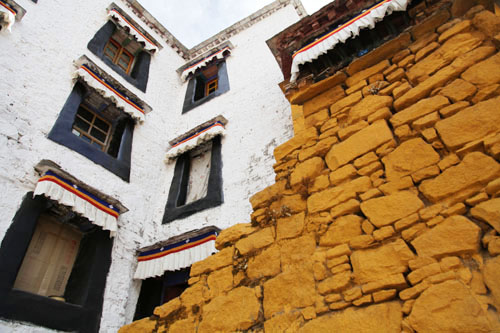
Sera means wild rose in the Tibetan language. The origin of the name 'Sera' is attributed to the fact that the site on which the monastery was built was surrounded by wild roses in bloom. One of the most interesting times to visit the monastery is in the afternoon when monks, after finishing their morning scripture classes, can be seen debating in the courtyard.

According to the local tradition, lamas must participate in debates to further their comprehension and proceed to more advanced levels of study. The debate usually lasts about one hour and a half. In a battle of words, they supplement their efforts by using a variety of gestures including clapping their hands, pushing their partners for an answer, or plucking their prayer beads to win the virtue of the Buddha.
The Precious:
Ganden Monastery
Wonder to Witness: A trove of exquisite craftsmanship of extreme cultural importance
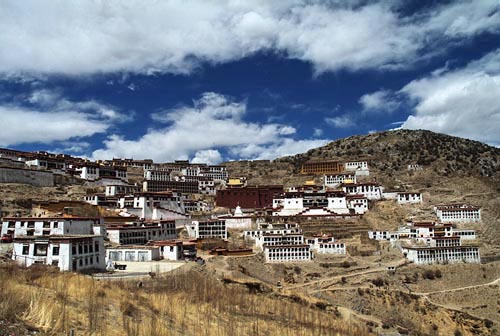
Ganden Monastery is one of the earliest and largest Buddhist monasteries in Tibet. Its significance as a religious, artistic, political and cultural relic led to it being preserved by the National Key Cultural Relic Preservation scheme as early as 1961. The monastery boasts rare and well-preserved cultural relics, such as the armor of Qing Dynasty. This armor is studded with jewels and engraved with four kinds of characters. There are also exquisite tapestries, the sutra written in gold known as the National Super-Class Cultural Relic, and a set of Thangka painted with sixteen arhats and the four Heavenly Kings.
The Unique:
Drak Yerpa Monastery
Wonder to Witness: The inexplicable combination of cave and meditation
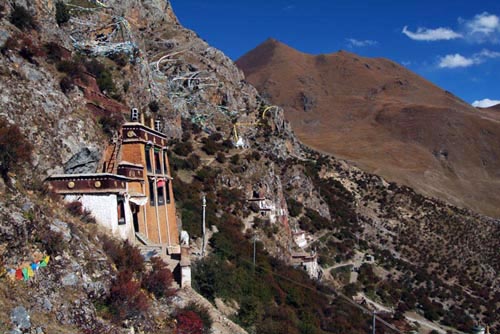
Long periods of meditation in Tibet are often carried out in caves, and Drak Yerpa monastery has some of the oldest and famous meditation caves in the area. Built on a hillside with more than 80 meditation caves, Drak Yerpa is described as the "life tree" or spiritual axis of Lhasa. Some of the caves are associated with the great names of Tibetan Buddhism: Songtsan Gampo, the first ruler of a united Tibet; Padmasambhava, a sage guru who was instrumental in bringing Buddhism to Tibet in the 8th century; and Lhalung Pelgyi Dorje, one of the twenty-five disciples of Padmasambhava who is said to have hidden here after assassinating an anti-Buddhist King.
And Last but not least -- The Amusing:
Drashilhakang Monastery
Wonder to Witness: The goddess who 'drinks'
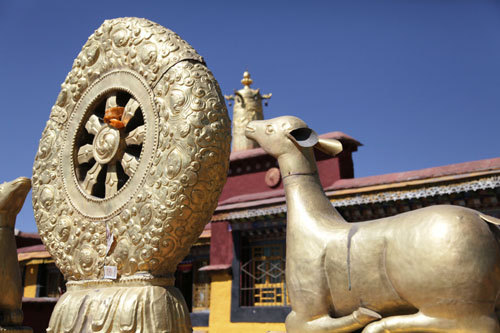
Holding all the necessary offerings, people line up at Drashilhakang Monastery, in Lhasa to serve one goddess. The local people said the Drashihakang Goddess originally came from the Chinese mainland, in search of Buddhist truth. She was very faithful, wise and also born extremely pretty. Year after year, she's become one of the most popular Buddhist gods in Lhasa. Giving offerings to the Drashihakang Goddess is only the first part of the worship process. The next part is to walk around the main hall clockwise and give your gift money to each Buddha worshiped here. Many people exchange their gifts into smaller notes from an open money pool. Nobody watches the money, but no one takes away a penny.
 0
0 






